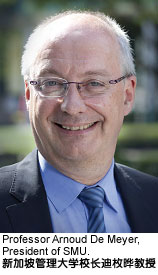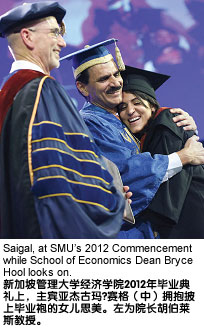 There are two museums located right next door to the Singapore Management University (SMU): The Singapore Art Museum and the National Museum of Singapore.
There are two museums located right next door to the Singapore Management University (SMU): The Singapore Art Museum and the National Museum of Singapore.
As a nimble educational institution, SMU was quick to act. It introduced a course which is unique in Singapore - a major in Arts and Culture Management. "We are lucky to be so close to two museums. In addition, we have good contacts with the School of the Arts next door. We felt that there is a growing need for students who are able to go into the arts and culture sector," said SMU President, Professor Arnoud De Meyer.
"We did it gradually, first starting it as an elective to see the response from our students. When that was successful we launched it as a second major. And we recruited faculty members from Scotland, England, and the United States to teach the courses."
A Success Story
From its inception, SMU was tasked to provide a different model of university education in Singapore.
12 years later, its attractiveness can be seen in its steadily rising enrolment figures, which have now hit almost maximum capacity levels. The intake for the current academic year was 1,950, which was an increase of 200 students, or about 11 per cent, over the previous year. But the university is unlikely to be able to keep expanding at this rate, despite its obvious popularity.
The increase this year saw the numbers in the School of Social Sciences go from 140 to 240, and in the School of Economics from 180 to 250. Professor De Meyer predicts that admissions to these Schools will stabilise soon, but that there will be some growth in the School of Law because, with about 120 students, it is still quite small.
To underline the point about its success, the university now has almost 8,000 students - 7,000 undergraduates and 900 postgraduates - despite the fact that it was originally built for no more than 6,900.
 "Many of the postgraduate students come in on the weekends and in the evenings. Therefore we are not that bad in terms of capacity utilisation. But we are growing the undergraduate population, and this year we took in an additional 200 students. In a few years' time we will have 600 to 700 more students than in the past. So we will need more space for these students because we are really full at the moment." "Many of the postgraduate students come in on the weekends and in the evenings. Therefore we are not that bad in terms of capacity utilisation. But we are growing the undergraduate population, and this year we took in an additional 200 students. In a few years' time we will have 600 to 700 more students than in the past. So we will need more space for these students because we are really full at the moment."
Fortunately, some plots of land were earmarked for the university at its inception, so a desirable location is already guaranteed for its next building. "I'm just glad we're not competing for commercial land," said Professor De Meyer.
Meeting Real Needs
The attraction of SMU is that it is very much in tune with industries and businesses. It identifies gaps in the education system and develops programmes to fill these gaps, often moving in line with government policies.
"We have several ways of trying to figure out what the market wants. Across our schools, the professors have very close contacts with recruiters and companies, because sometimes they do research or consulting for them, so they pick up some signals. We also have the office of strategic planning that monitors the market for its needs. We try to be market-oriented, to fill its gaps and respond swiftly to what it wants. We listen carefully. It's the role of the university to do research, to teach well and to listen to its partners," explained Professor De Meyer.
>> More
To read full content, please subscribe
|